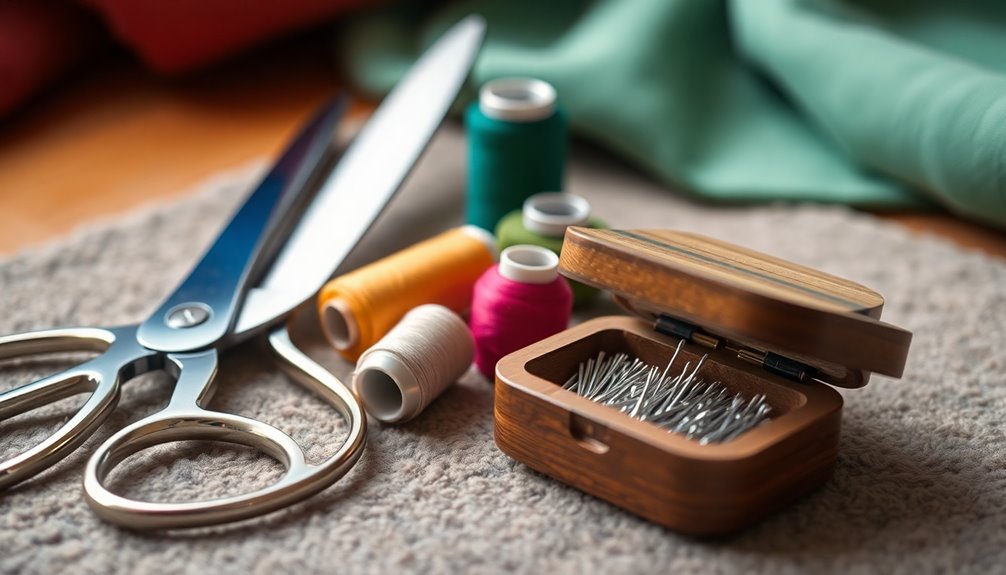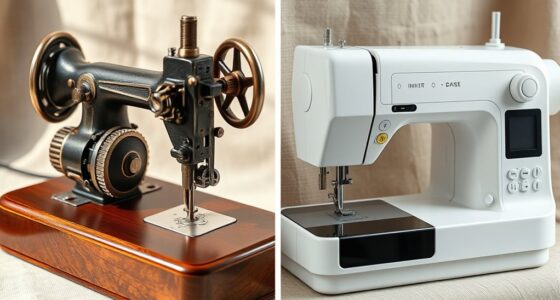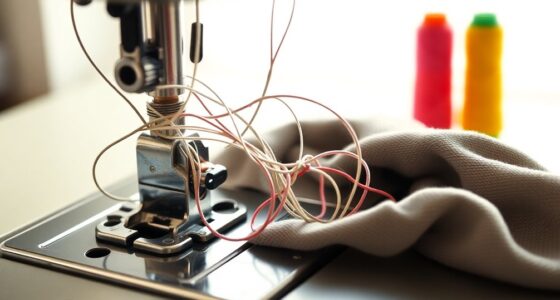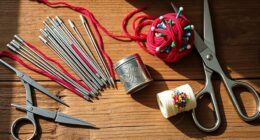To care for your sewing tools properly, regularly clean and maintain each item. Make certain to oil your sewing machine, clean the bobbin case after each use, and sharpen your scissors to keep them effective. Avoid dust buildup by regularly deep cleaning your machine and organizing tools in a dry space. Store scissors closed and point-down to prevent damage. By following these tips, you'll enhance your sewing experience and guarantee your tools last longer, leading to even better results.
Key Takeaways
- Establish a regular cleaning schedule for your sewing machine, including wiping down surfaces and cleaning the bobbin case after each use.
- Store scissors and cutters closed and point-down in a heavy container to prevent damage and accidents.
- Organize and store threads in drawers away from humidity, dust, and light to maintain quality and prevent tangling.
- Inspect and sharpen scissors and cutting tools regularly to ensure precision and avoid accidents during sewing.
- Consult your sewing machine manual for specific cleaning and maintenance instructions to prolong its lifespan and performance.
Importance of Keeping Sewing Tools and Equipment in Good Condition
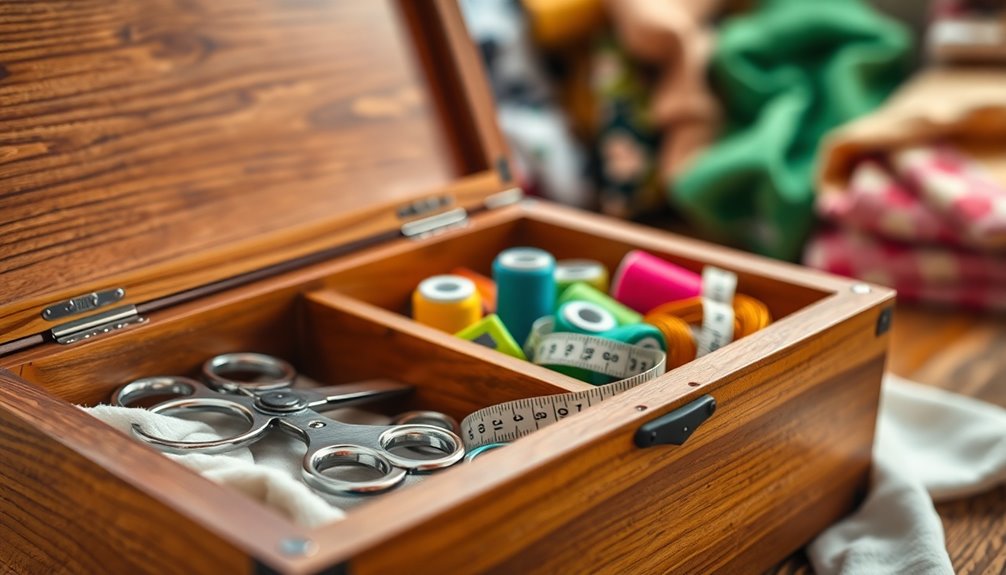
Sewing tools are the backbone of any successful project, and keeping them in good condition is essential. Regular cleaning and maintenance can greatly extend their lifespan, saving you from costly repairs that could exceed your original investment.
When you're familiar with well-maintained tools, you'll feel more efficient and comfortable while sewing, which reduces anxiety and boosts satisfaction. Preventive care, like using sewing machine oil regularly, is far more cost-effective than waiting for issues to arise.
Additionally, high-quality thread and needles maintain your machine's integrity, preventing frustrating thread breakage and fabric damage. By ensuring your sewing tools are in top shape, you foster a smoother workflow, enhancing your overall sewing experience and project outcomes.
Consequences of Neglecting Sewing Machine Care
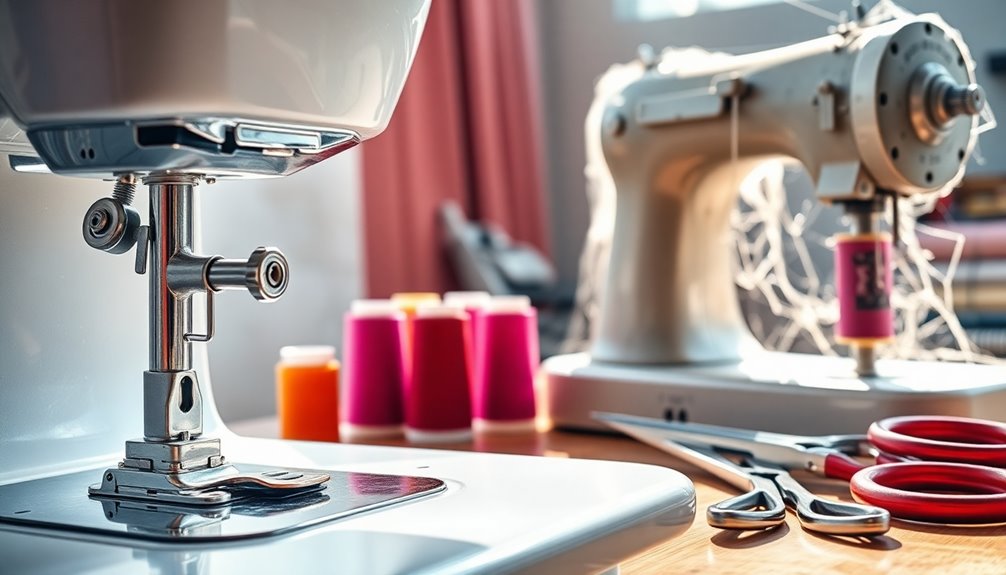
Neglecting your sewing machine's care can lead to frequent needle breaks, disrupting your projects and costing you money in replacements.
You might also notice poor stitch quality, making your finished pieces look less professional.
Over time, these issues can add up, increasing repair costs and potentially shortening your machine's lifespan.
Frequent Needle Breakage
Frequent needle breakage can be a frustrating issue for any seamstress, often stemming from inadequate care of your sewing machine. Dust and debris build-up can misalign components, increasing tension on the needle.
To prevent this, use quality thread; low-quality options create excessive friction, making breakage more likely. Change your needles regularly—after every eight hours of sewing or each project—to guarantee peak performance.
Misthreading your machine or incorrect tension settings can also strain the needle, leading to snapping.
Don't forget preventive maintenance: clean your bobbin case and keep your machine well-oiled.
Poor Stitch Quality
When needle breakage becomes a common issue, it often signals deeper problems with your sewing machine's care.
Poor stitch quality can arise from neglected regular maintenance, leading to lint and dust buildup. This accumulation can cause thread bunching, skipped stitches, and uneven seams. A dirty bobbin case might disrupt tension, further compromising your stitch quality and increasing the risk of thread breakage.
It's vital to use high-quality thread; low-quality or inappropriate options can fray and leave residue in your machine.
Don't forget to change needles regularly, as dull needles create larger holes and skipped stitches.
Increased Repair Costs
If you overlook regular maintenance of your sewing machine, you'll likely face increased repair costs that can quickly add up.
Regularly neglecting your machine can lead to frequent needle breaks, costing you between $75 and $125 each time.
Dust and debris accumulation can cause thread bunching, requiring professional servicing and further expenses.
Failing to clean the bobbin case can disrupt seam quality, leading to uneven stitching, which also incurs repair costs.
Using low-quality thread may damage your machine over time, resulting in even higher repair costs.
Finally, ignoring routine checks can cause mechanical failures, sometimes costing more than your initial investment in the sewing machine.
To avoid these expenses, give your sewing machines the good care they deserve.
Essential Maintenance and Repair for Sewing Machines
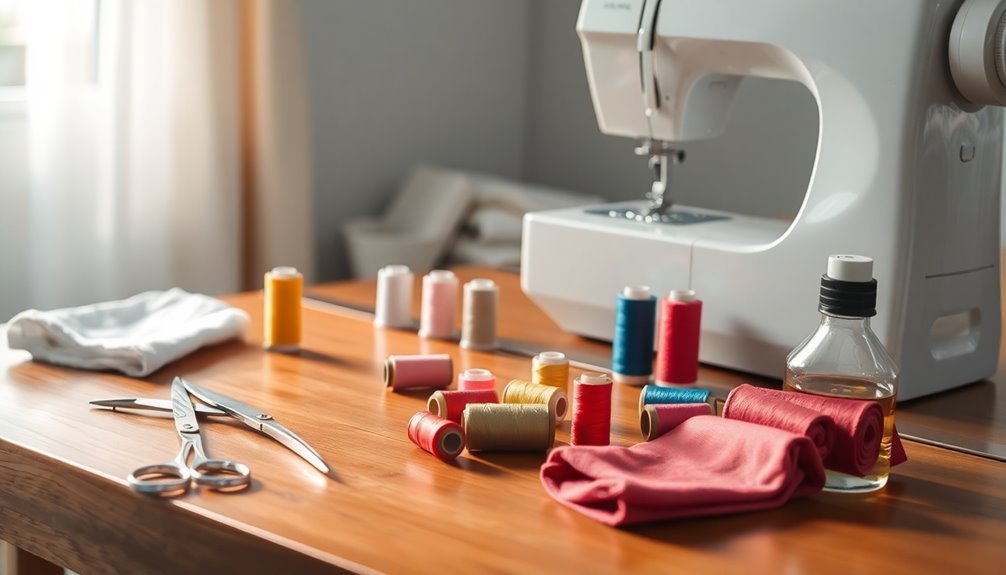
To keep your sewing machine running smoothly, you need a regular cleaning schedule.
Dust and lint can build up quickly, so make it a habit to clean the bobbin case after each session.
Also, consider professional maintenance at least once a year to catch any issues before they become bigger problems.
Regular Cleaning Schedule
Regularly cleaning your sewing machine is essential for maintaining its performance and longevity.
To keep your machine in top shape, follow this simple cleaning schedule:
- After Each Session: Wipe down the machine's surface and remove lint with a brush or chenille stem around the bobbin case.
- Monthly Deep Clean: Set a recurring reminder to perform a thorough cleaning and inspection, checking for any dust buildup in hard-to-reach areas.
- Refer to the Manual: Always consult your machine's manual for specific cleaning instructions to guarantee you're treating your sewing machine properly.
Professional Maintenance Recommendations
Maintaining your sewing machine through regular cleaning is a great start, but professional maintenance is equally important for keeping it in peak condition. Schedule a professional service at least once a year, especially if you sew frequently. Unplug the machine before servicing for safety, and let experienced technicians handle detailed inspections and cleaning of internal parts. They can replace worn components that aren't easily accessible to you and identify potential issues early, saving you from costly repairs later.
| Service Type | Cost Range |
|---|---|
| Basic Inspection | $75 – $125 |
| Deep Cleaning | $75 – $125 |
| Component Replacement | $75 – $125 |
With professional maintenance, you'll keep your equipment in good shape for years to come.
Care and Maintenance of Sewing Tools
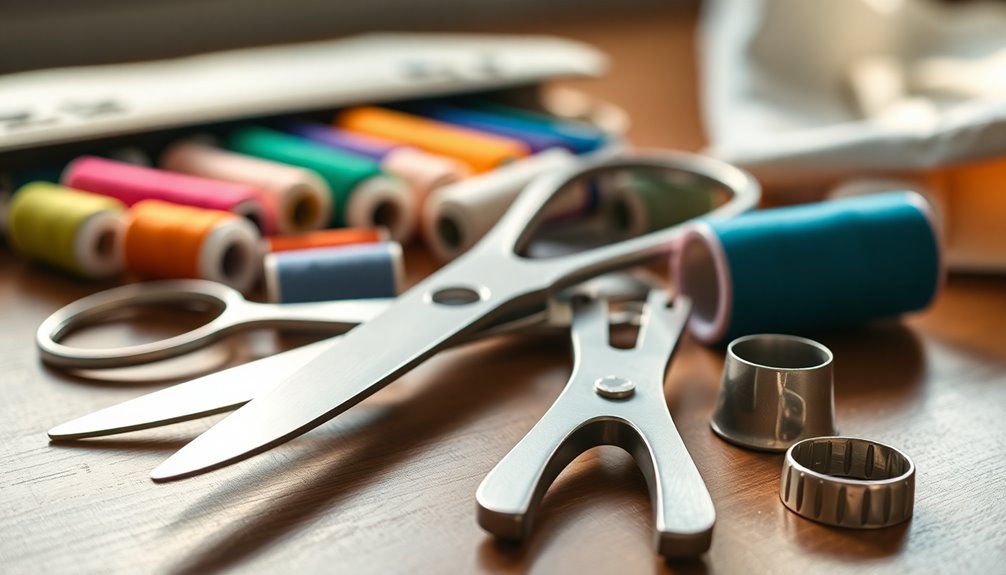
Caring for your sewing tools is essential for ensuring they perform well and last longer. Here are some key maintenance tips to keep your sewing machine, sewing scissors, and cutting tools in top shape:
- Clean Your Sewing Machine: Dust or vacuum after each use and follow the manufacturer's cleaning instructions to maintain peak performance.
- Store Your Sewing Scissors Properly: Keep them closed and point-down in a heavy container, designating specific scissors for fabric to avoid damage.
- Maintain Your Cutting Tools: Clean your cutting mat regularly by rubbing an eraser over it and washing with mild dish soap to preserve its usability.
Storage Solutions and Additional Care Tips
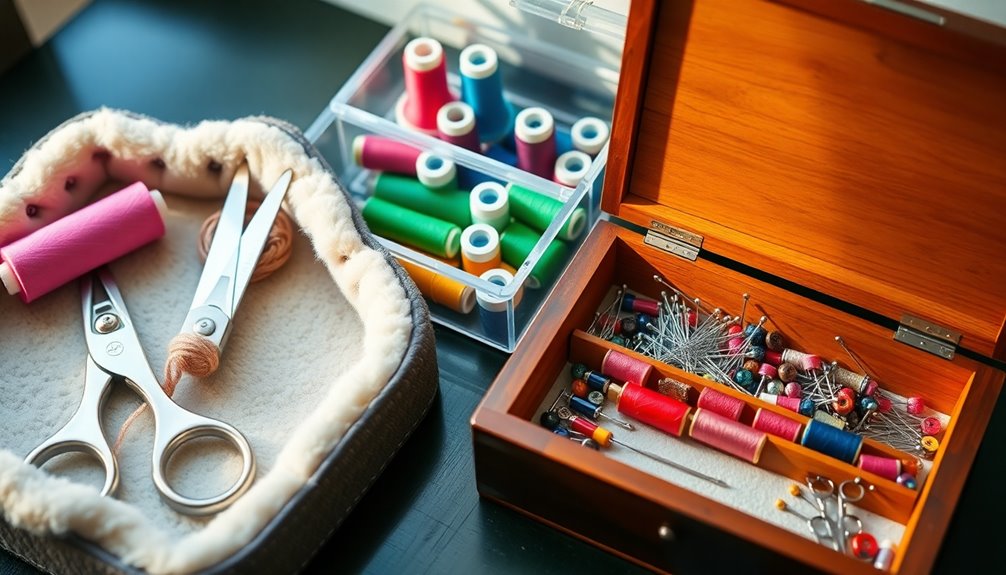
Effective storage solutions can markedly enhance the longevity and usability of your sewing tools.
Store threads in drawers away from humidity, dust, and light to keep them in top condition. Use pincushions for pins and needles, and keep original containers to prevent loss.
Roll measuring tapes to avoid tangling and guarantee they stay functional. Organize multiple bobbins in designated cases for easy access and to prevent them from getting tangled.
Protect your sewing machine and tools with covers to avoid dust accumulation and damage from sunlight or impacts.
Finally, incorporate quick cleaning routines to maintain your tools' functionality, guaranteeing they're always ready for your next sewing project.
Why Is Sewing Scissors and Cutters Maintenance Important?
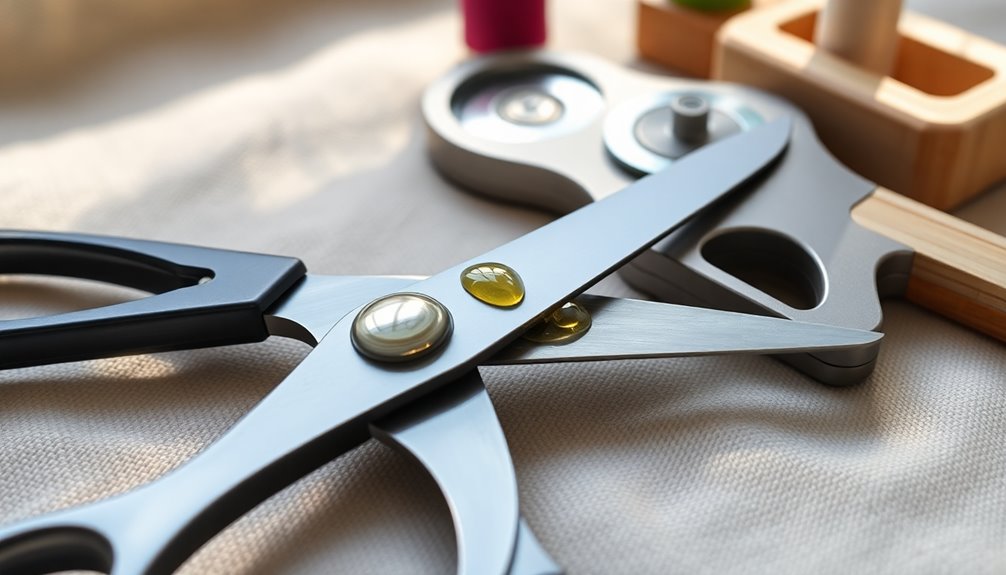
Properly storing your sewing tools not only keeps them organized but also sets the stage for their maintenance, especially when it comes to scissors and cutters.
Regular maintenance is essential for several reasons:
- Sharpness: Well-maintained scissors and cutters stay sharp, preventing fabric damage and ensuring clean cuts.
- Cost-Effective: Routine care reduces the need for frequent replacements, saving you money in the long run.
- Safety: Regularly inspecting and sharpening your tools helps prevent accidents, keeping your sewing experience safe and enjoyable.
Dull scissors can create uneven stitches and larger holes in fabric, leading to frustration.
Tips for Caring for Your Sewing Scissors and Cutters
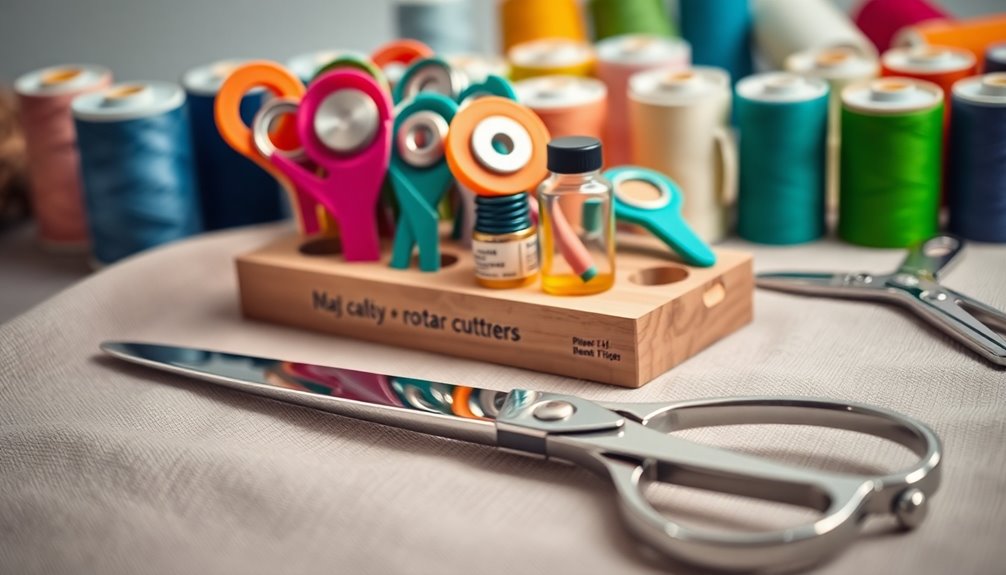
Maintaining your sewing scissors and cutters is essential for achieving precise cuts and enhancing your overall sewing experience.
Store your scissors securely, with blades closed and point-down in a heavy container to prevent drops and damage.
Incorporate cleaning into your routine after each sewing session; use a microfiber cloth to wipe the blades and maintain sharpness.
Designate specific scissors for fabric only, avoiding paper or other materials to preserve their effectiveness. Keeping these scissors sharp will enhance your precision when cutting, which is crucial for achieving clean edges and accurate pattern pieces. For those exploring sewing techniques for nylon fabric, it’s essential to use the right tools, as nylon can be tricky to cut and sew. Proper care of your fabric scissors, combined with the appropriate techniques, will yield the best results in your sewing projects.
For stubborn dirt, use a cotton ball dipped in a vinegar solution (1 tbsp vinegar, 2 cups water) to clean the blades, drying them immediately afterward.
Regularly check the sharpness of your scissors, as dull blades can lead to larger holes in fabric and uneven stitches.
Learn Which Scissors or Cutters to Use for Which Material
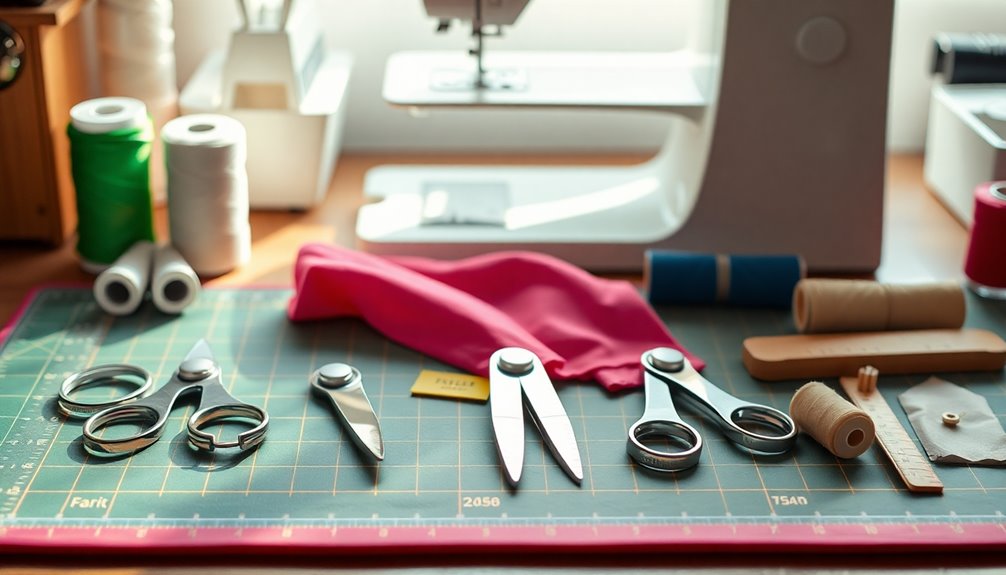
Choosing the right scissors or cutters for your projects can make all the difference in your sewing experience.
Using the appropriate tools for different materials guarantees clean cuts and saves you time. Here's a quick guide to help you:
- Upholstery Shears: Perfect for thick materials like denim, canvas, and upholstery fabric.
- Standard Sewing Shears: Ideal for lighter fabrics such as cotton, linen, and silk for precise cutting.
- Rotary Cutters: Great for cutting multiple layers evenly, especially useful in quilting projects.
Frequently Asked Questions
How Do You Take Care of Your Sewing Tools?
To take care of your sewing tools, start by cleaning your sewing machine after each session—dust the bobbin case and brush away lint.
Store your scissors and rotary cutters safely, keeping blades closed. Use high-quality thread to cut down on lint and improve stitching.
Clean your acrylic rulers with a vinegar solution for best results, and don't forget to change needles regularly to keep your projects running smoothly and avoid fabric damage.
How to Take Care of Sewing Needles?
Imagine your sewing project flowing smoothly, each stitch precise and perfect.
To keep your needles in top shape, change them after about eight hours of use or at the start of a new project. Always match the needle type to your fabric—universal for wovens, ballpoint for knits.
Inspect them for dullness or bending before you start, and store used needles safely in a dedicated container. Dispose of damaged needles properly to avoid accidents.
How Should Sewing Tools Be Stored to Prevent Damage?
To prevent damage to your sewing tools, store scissors closed and point-down in a cushioned container.
Keep rotary cutters secured with the blade closed in a cool, dry place.
Rulers and templates should lie flat to avoid warping.
Organize threads in drawers, shielded from humidity and light.
Finally, use protective cases for cutting tools to guard against dust and environmental factors, ensuring everything remains in top condition for your projects.
How to Care for Cutting Tools?
To care for your cutting tools, always store scissors and rotary cutters in a closed position to prevent accidents and protect the blades.
Regularly clean the blades with a microfiber cloth to keep them sharp and free from residue.
Use the right cutting tool for each material, and change rotary cutter blades when they dull.
Keep your tools in a designated area, using protective cases to avoid damage from drops or falls.
Conclusion
Taking care of your sewing tools isn't just about preserving them; it's about enhancing your creativity. Did you know that properly maintained sewing machines can last up to 25 years longer than neglected ones? By investing a little time in regular maintenance and proper storage, you'll not only extend the life of your tools but also improve your sewing experience. So, keep your tools in top shape, and enjoy every stitch you create!
